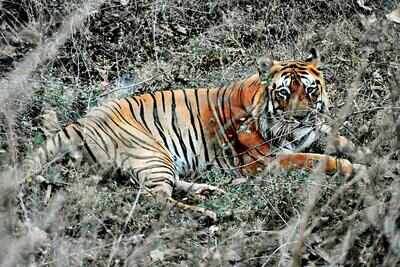
Nagpur: On November 30, 2007 a tiger was shot dead in Talodi in Brahmapuri division after it killed five people and a dozen cattle in one month. Five years down the line, people seem to have learnt to coexist as a result of better monitoring and wildlife management so much so that the National Tiger Conservation Authority (NTCA) in 2012 had considered Brahmapuri model to be implemented in other tiger states too. But, in the last three years, man-animal conflict has taken a turn for the worse, thanks to several errors by the field staff and officials.
The man-animal conflict figures speak for itself. In over three years (2016-2019), 34 human deaths and 304 cases of human injures have been officially reported in wild animal attacks in Brahmapuri division alone. The government paid Rs16.52 crore compensation which includes for cattle kills and crop damage.
The conflict, which was at its peak in 2007, resolved steadily between 2010-2015, when the number of human deaths during these 6 years was 25. On the contrary, a shocking 34 people have died in conflict in the division alone during last little over three years (2016 till April 2019), exposing the gravity of man-animal conflict and problems thereon.
The forest is more or less in fragmented blocks adjoining Tadoba Andhari Tiger Reserve (TATR) with paddy fields in between. Of the 750 villages in Brahmapuri, 449 are forested. So, what has gone wrong with the division, which was once dubbed to be a model by NTCA for tiger states?
It is not that the tiger numbers have gone down or people have stopped venturing into the forests. Villagers, who were learning to coexist after the Talodi episode, are now up in arms against the forest department.
One of the prime reasons, recalls Ashok Dhote, who spent over 7 long years as assistant conservator of forest (ACF) in Brahmapuri from 2006-2013, “Post-Talodi, we learnt many lessons and started chronicling tigers as T1, T2, T3… and so on. We conducted suo motu tiger census and prepared home range of every big cat and mapped human deaths, cattle kills and tiger presence.”
Dhote along with the then deputy conservator (DyCF) Sanjay Thawre was instrumental in tabulating tiger data and prepared history-sheet of every tiger in 7 ranges — Sindewahi, South Brahmapuri, Saoli, North Brahmapuri, Talodi, Nagbhid and Chimur teeming with tigers.
“Field staff was able to classify new entrants as well as resident tigers. Better monitoring helped in knowing movement, corridors, breeding, conflict etc. Besides, capacity-building proved advantageous. We were even awarded gold medal in 2011-12 for wildlife management by the state government,” says Dhote.
Today, the man-animal conflict has gone haywire with four deaths in April alone. “It is true that good work done by Thawre then has paid off and due to better protection and monitoring tiger numbers also increased, but there is not one reason for flared up are multiple reasons for conflict,” says Eco-Pro founder Bandu Dhotre.
During the last few years, habitat destruction owing to projects like Gosikhurd canal and road widening have fragmented 1,500 sqkm Brahmapuri forest. “Besides, of the 605 villages more than 50% (355) are on forest fringes putting huge biotic pressure and making villagers vulnerable to attacks,” says Dhotre.
As per the WII report (2018) on forest fragments, Chandrapur district, which harbours over 150 tigers, has only 1 patch which is above 500 sqkm and only 3 patches between 100-500 sq km. This is an indication of fragmentation and deterioration in habitat quality. As per NTCA guideline, 20 breeding tigresses need an inviolate area of 800-1,000 sqkm around tiger reserves.
“Competition for mahua collection owing to better price due to prohibition in Chandrapur district is one of the reasons for increase in animal attacks. Mahua flowers, which earlier used to be available for Rs15-20 per kg, now fetch Rs80-100 per kg, making it a good livelihood option for locals. Most of the victims attacked were mahua collectors,” says Dhotre.
On the contrary, Madhukar Madavi (62), chairman of Sindewahi Panchayat Samiti, who has been closely watching the conflict, attributed the problem to human interference in forest owing to unemployment. Brahmapuri is an agrarian economy with marginal farmers which depends on forest for seasonal forest produce like mahua, gum and tendu and also fuelwood. “People have been traditionally venturing into the forest and prohibition has nothing to do with spurt in collection of mahua flowers,” he says.
“The issue is on one hand forest department could increase number of tigers due to various strategic measures but their habitat is shrinking. The field staff is too short in numbers to protect them owing to multiple duties and vast beat areas to man,” said Madavi.
The forest department efforts towards community development through joint forest management committees (JFMCs) are visible to some extent but are proving insufficient. Citing an example of subsidized LPG in Sindewahi, Madavi says, “The tehsil has distributorship for Indane but department is giving cylinders for Hindustan Petroleum, for which locals have to travel 30km to Navargaon to get a LPG tank. This is one of the reasons fuelwood collection from forest is still rampant,” says Madavi.
Vilas Urkude, vice-chairman of Brahmapuri Panchayat Samiti, agrees with Madavi. “Over 50% of the villages are completely dependent on forest but the government is concerned more about tigers than people. The Rs15 lakh compensation package is no match to human lives and focus should be on preference to employment in forested villages.”
Urkude called for strong monitoring measures and infrastructure like vehicles and protection huts for staff to man the jungle. “Most of the time forest staff reaches late at the incident spots inviting ire of the villagers. Bamboo extraction is big livelihood of locals from which they earn at least Rs1,000 by selling household articles. Government should take steps to provide bamboo to the people at their doorstep to curb conflict,” says Urkude.
Wildlife Institute of India (WII) scientist Bilal Habib, who radio collared at least 7 tigers in Brahmapuri, calls for vigilant field staff, especially during tendu and mahua season. “Most of the victims are non-timber forest produce (NTFP) collectors. No one should enter the forest without the knowledge of local forest staff. All breeding felines should be monitored as these are more prone to conflict. One of the major reasons for conflict is also rise in number of tigers,” he said.
Pawan Nagre of ZEP Nisarga Mitra Sanstha, Nagbhid, doesn’t agree. “There is no smoke without fire and one of the key reasons for conflict is that protection system has collapsed. As 90% of the forest was gutted in fires, herbivores turned to villages followed by predators. Secondly, mahua collectors, who venture deep into forest during wee hours, become victim as they pick flowers in crouch position which is assumed by carnivores as an animal.”
A wildlife lover from Talodi speaking on condition of anonymity said, “Wanderers have free run in forests of Brahmapuri. I’ve been a regular visitor to these forests and never see a guard or forester stopping me from sighting animals. There are many youths from Chandrapur and nearby towns who roam in the forest freely.”
“Things have gone from bad to worse in Brahmapuri as local poachers are active and kill wild animals for bush meat. Electrocution is also rampant and as herbivores are being poached regularly, prey base has dwindled forcing tigers to become cattle lifters causing conflict,” says Amod Gaurkar, founder of Tarun Paryavaran Mandal, Shankarpur.
Even collared tigers are involved in attacks. Villagers of Ekara and Rampuri confirmed a collared tiger attacked them on April 7, morning. Since June 2016, several individuals were captured and collared by WII. In 2018, Brahmapuri came into limelight due to legal challenges in the high court against faulty tiger-capture proposals and the chief wildlife warden orders later being stayed by the court.
“These legal challenges have repeatedly highlighted violations of NTCA SOPs by Brahmapuri officials while dealing with conflict tigers. Fearing further legal challenges, they resorted to complete secrecy while taking up such operations,” states Dr Jerryl Banait, who challenged one of the tiger capture orders.
Citing a classic example, Dr Banait said then chief wildlife warden issued capture order of T-17 (Girgaon) and her four cubs in March 2018. The order, which was stayed by the high court, was issued despite the tigress not a problem one.
This non-transparency of the forest department is to the extent that even when three radio-collared tigers were involved in recent human deaths in Arjuni and Navegaon beats of South Bramhapuri, no statement was issued by Brahmapuri deputy conservator (DyCF) Kulraj Singh. Singh did not respond to TOI calls.
“Forest department has sidelined NGOs, media and local wildlife lovers and has hired an unqualified ‘wildlife biologist’ on unsubstantiated tiger capture proposals. Such individuals have been selectively ‘favoured’ ostensibly to see they toe the forest department line,” said sources.
Wildlife lovers also point to rampant illegal tree felling and carting away of timber in bulk in bullock carts. “Are forest staff not aware of this activity which happens in broad daylight? Are they looking the other way on purpose? Such activities indicate complicity of the forest guards as villagers won’t dare to do such rampant activities by themselves,” said local conservationists from Brahmapuri.
“This war against tigers is not restricted to individual animals but complete population of tigers has been compromised by Brahmapuri officials by allowing expansion of Nagbhid-Brahmapuri road, which cuts the prime corridor connecting Tadoba-Brahmapuri-Umred-Karhandla sanctuary. The said area has been declared as a notified corridor as per the Tiger Conservation Plan (TCP) of TATR,” says wildlife conservationist Udayan Patil.
“Such rampant development even in the glare of NGT notice reflects apathy of forest officials. These actions are a clear indication that officers don’t want tigers in their division as they are unable to manage complexities of this unique landscape,” says Gaurkar.
“Conflict is not dependant on the density of tigers. Central Chanda and Brahmapuri have comparable tiger densities. However, there are very few incidents of conflict in Central Chanda compared to Brahmapuri. One of the major factors governing conflict is the extent of anthropogenic pressure and the quality of habitat,” says Aditya Joshi, wildlife biologist, who has extensively worked in the landscape.
“Considering the importance of Brahmapuri landscape, which has an immense position in tiger conservation in TATR landscape, there is need for a conservation plan to be implemented to decide carrying capacity and maintain continuity extended to Gadchiroli forest circle,” says wildlife conservationist Prafulla Bhamburkar.
Ugly Face of Conflict
Year Deaths
2010 7
2011 8
2012 3
2013 1
2014 4
2015 2
2016 7
2017 8
2018 13
2019 5
(Till Mar)
BOX II
Year Compensation
2011-12 Rs58.66 lakh
2012-13 Rs61.93 lakh
2013-14 Rs79.53 lakh
2014-15 Rs1.65 crore
2015-16 Rs3.70 crore
2016-17 Rs4.17 crore
2017-18 Rs5.38 crore
2018-19 Rs8.64 crore
(Human deaths, injuries, cattle kill, injuries & crop damage)
BOX III
Fragment Forests
Area Patches
1-5 412
5-10 58
10-50 42
50-100 4
100-500 3
500 above 1
(Area in sqkm)
BOX IV
What Ails This Tiger Land?
* From 9 tigers in 2006, camera traps have recorded 20 tigers and 6 cubs in 2012, the number is somewhere between 40-42 in 2019
* The division has 1,566 sq km area of which 281 sq km is with Forest Development Corporation of Maharashtra (FDCM), where wildlife management is extremely poor
* Under pressure, at least 6 tigers were captured in last three years from Brahmapuri. Two died post release while others have been brought to Gorewada rescue centre
* Of the 7 tigers kept in Gorewada Rescue Centre at Nagpur, 4 have been captured from Brahmapuri division alone in last couple of years
The man-animal conflict figures speak for itself. In over three years (2016-2019), 34 human deaths and 304 cases of human injures have been officially reported in wild animal attacks in Brahmapuri division alone. The government paid Rs16.52 crore compensation which includes for cattle kills and crop damage.
The conflict, which was at its peak in 2007, resolved steadily between 2010-2015, when the number of human deaths during these 6 years was 25. On the contrary, a shocking 34 people have died in conflict in the division alone during last little over three years (2016 till April 2019), exposing the gravity of man-animal conflict and problems thereon.
The forest is more or less in fragmented blocks adjoining Tadoba Andhari Tiger Reserve (TATR) with paddy fields in between. Of the 750 villages in Brahmapuri, 449 are forested. So, what has gone wrong with the division, which was once dubbed to be a model by NTCA for tiger states?
It is not that the tiger numbers have gone down or people have stopped venturing into the forests. Villagers, who were learning to coexist after the Talodi episode, are now up in arms against the forest department.
One of the prime reasons, recalls Ashok Dhote, who spent over 7 long years as assistant conservator of forest (ACF) in Brahmapuri from 2006-2013, “Post-Talodi, we learnt many lessons and started chronicling tigers as T1, T2, T3… and so on. We conducted suo motu tiger census and prepared home range of every big cat and mapped human deaths, cattle kills and tiger presence.”
Dhote along with the then deputy conservator (DyCF) Sanjay Thawre was instrumental in tabulating tiger data and prepared history-sheet of every tiger in 7 ranges — Sindewahi, South Brahmapuri, Saoli, North Brahmapuri, Talodi, Nagbhid and Chimur teeming with tigers.
“Field staff was able to classify new entrants as well as resident tigers. Better monitoring helped in knowing movement, corridors, breeding, conflict etc. Besides, capacity-building proved advantageous. We were even awarded gold medal in 2011-12 for wildlife management by the state government,” says Dhote.
Today, the man-animal conflict has gone haywire with four deaths in April alone. “It is true that good work done by Thawre then has paid off and due to better protection and monitoring tiger numbers also increased, but there is not one reason for flared up are multiple reasons for conflict,” says Eco-Pro founder Bandu Dhotre.
During the last few years, habitat destruction owing to projects like Gosikhurd canal and road widening have fragmented 1,500 sqkm Brahmapuri forest. “Besides, of the 605 villages more than 50% (355) are on forest fringes putting huge biotic pressure and making villagers vulnerable to attacks,” says Dhotre.
As per the WII report (2018) on forest fragments, Chandrapur district, which harbours over 150 tigers, has only 1 patch which is above 500 sqkm and only 3 patches between 100-500 sq km. This is an indication of fragmentation and deterioration in habitat quality. As per NTCA guideline, 20 breeding tigresses need an inviolate area of 800-1,000 sqkm around tiger reserves.
“Competition for mahua collection owing to better price due to prohibition in Chandrapur district is one of the reasons for increase in animal attacks. Mahua flowers, which earlier used to be available for Rs15-20 per kg, now fetch Rs80-100 per kg, making it a good livelihood option for locals. Most of the victims attacked were mahua collectors,” says Dhotre.
On the contrary, Madhukar Madavi (62), chairman of Sindewahi Panchayat Samiti, who has been closely watching the conflict, attributed the problem to human interference in forest owing to unemployment. Brahmapuri is an agrarian economy with marginal farmers which depends on forest for seasonal forest produce like mahua, gum and tendu and also fuelwood. “People have been traditionally venturing into the forest and prohibition has nothing to do with spurt in collection of mahua flowers,” he says.
“The issue is on one hand forest department could increase number of tigers due to various strategic measures but their habitat is shrinking. The field staff is too short in numbers to protect them owing to multiple duties and vast beat areas to man,” said Madavi.
The forest department efforts towards community development through joint forest management committees (JFMCs) are visible to some extent but are proving insufficient. Citing an example of subsidized LPG in Sindewahi, Madavi says, “The tehsil has distributorship for Indane but department is giving cylinders for Hindustan Petroleum, for which locals have to travel 30km to Navargaon to get a LPG tank. This is one of the reasons fuelwood collection from forest is still rampant,” says Madavi.
Vilas Urkude, vice-chairman of Brahmapuri Panchayat Samiti, agrees with Madavi. “Over 50% of the villages are completely dependent on forest but the government is concerned more about tigers than people. The Rs15 lakh compensation package is no match to human lives and focus should be on preference to employment in forested villages.”
Urkude called for strong monitoring measures and infrastructure like vehicles and protection huts for staff to man the jungle. “Most of the time forest staff reaches late at the incident spots inviting ire of the villagers. Bamboo extraction is big livelihood of locals from which they earn at least Rs1,000 by selling household articles. Government should take steps to provide bamboo to the people at their doorstep to curb conflict,” says Urkude.
Wildlife Institute of India (WII) scientist Bilal Habib, who radio collared at least 7 tigers in Brahmapuri, calls for vigilant field staff, especially during tendu and mahua season. “Most of the victims are non-timber forest produce (NTFP) collectors. No one should enter the forest without the knowledge of local forest staff. All breeding felines should be monitored as these are more prone to conflict. One of the major reasons for conflict is also rise in number of tigers,” he said.
Pawan Nagre of ZEP Nisarga Mitra Sanstha, Nagbhid, doesn’t agree. “There is no smoke without fire and one of the key reasons for conflict is that protection system has collapsed. As 90% of the forest was gutted in fires, herbivores turned to villages followed by predators. Secondly, mahua collectors, who venture deep into forest during wee hours, become victim as they pick flowers in crouch position which is assumed by carnivores as an animal.”
A wildlife lover from Talodi speaking on condition of anonymity said, “Wanderers have free run in forests of Brahmapuri. I’ve been a regular visitor to these forests and never see a guard or forester stopping me from sighting animals. There are many youths from Chandrapur and nearby towns who roam in the forest freely.”
“Things have gone from bad to worse in Brahmapuri as local poachers are active and kill wild animals for bush meat. Electrocution is also rampant and as herbivores are being poached regularly, prey base has dwindled forcing tigers to become cattle lifters causing conflict,” says Amod Gaurkar, founder of Tarun Paryavaran Mandal, Shankarpur.
Even collared tigers are involved in attacks. Villagers of Ekara and Rampuri confirmed a collared tiger attacked them on April 7, morning. Since June 2016, several individuals were captured and collared by WII. In 2018, Brahmapuri came into limelight due to legal challenges in the high court against faulty tiger-capture proposals and the chief wildlife warden orders later being stayed by the court.
“These legal challenges have repeatedly highlighted violations of NTCA SOPs by Brahmapuri officials while dealing with conflict tigers. Fearing further legal challenges, they resorted to complete secrecy while taking up such operations,” states Dr Jerryl Banait, who challenged one of the tiger capture orders.
Citing a classic example, Dr Banait said then chief wildlife warden issued capture order of T-17 (Girgaon) and her four cubs in March 2018. The order, which was stayed by the high court, was issued despite the tigress not a problem one.
This non-transparency of the forest department is to the extent that even when three radio-collared tigers were involved in recent human deaths in Arjuni and Navegaon beats of South Bramhapuri, no statement was issued by Brahmapuri deputy conservator (DyCF) Kulraj Singh. Singh did not respond to TOI calls.
“Forest department has sidelined NGOs, media and local wildlife lovers and has hired an unqualified ‘wildlife biologist’ on unsubstantiated tiger capture proposals. Such individuals have been selectively ‘favoured’ ostensibly to see they toe the forest department line,” said sources.
Wildlife lovers also point to rampant illegal tree felling and carting away of timber in bulk in bullock carts. “Are forest staff not aware of this activity which happens in broad daylight? Are they looking the other way on purpose? Such activities indicate complicity of the forest guards as villagers won’t dare to do such rampant activities by themselves,” said local conservationists from Brahmapuri.
“This war against tigers is not restricted to individual animals but complete population of tigers has been compromised by Brahmapuri officials by allowing expansion of Nagbhid-Brahmapuri road, which cuts the prime corridor connecting Tadoba-Brahmapuri-Umred-Karhandla sanctuary. The said area has been declared as a notified corridor as per the Tiger Conservation Plan (TCP) of TATR,” says wildlife conservationist Udayan Patil.
“Such rampant development even in the glare of NGT notice reflects apathy of forest officials. These actions are a clear indication that officers don’t want tigers in their division as they are unable to manage complexities of this unique landscape,” says Gaurkar.
“Conflict is not dependant on the density of tigers. Central Chanda and Brahmapuri have comparable tiger densities. However, there are very few incidents of conflict in Central Chanda compared to Brahmapuri. One of the major factors governing conflict is the extent of anthropogenic pressure and the quality of habitat,” says Aditya Joshi, wildlife biologist, who has extensively worked in the landscape.
“Considering the importance of Brahmapuri landscape, which has an immense position in tiger conservation in TATR landscape, there is need for a conservation plan to be implemented to decide carrying capacity and maintain continuity extended to Gadchiroli forest circle,” says wildlife conservationist Prafulla Bhamburkar.
Ugly Face of Conflict
Year Deaths
2010 7
2011 8
2012 3
2013 1
2014 4
2015 2
2016 7
2017 8
2018 13
2019 5
(Till Mar)
BOX II
Year Compensation
2011-12 Rs58.66 lakh
2012-13 Rs61.93 lakh
2013-14 Rs79.53 lakh
2014-15 Rs1.65 crore
2015-16 Rs3.70 crore
2016-17 Rs4.17 crore
2017-18 Rs5.38 crore
2018-19 Rs8.64 crore
(Human deaths, injuries, cattle kill, injuries & crop damage)
BOX III
Fragment Forests
Area Patches
1-5 412
5-10 58
10-50 42
50-100 4
100-500 3
500 above 1
(Area in sqkm)
BOX IV
What Ails This Tiger Land?
* From 9 tigers in 2006, camera traps have recorded 20 tigers and 6 cubs in 2012, the number is somewhere between 40-42 in 2019
* The division has 1,566 sq km area of which 281 sq km is with Forest Development Corporation of Maharashtra (FDCM), where wildlife management is extremely poor
* Under pressure, at least 6 tigers were captured in last three years from Brahmapuri. Two died post release while others have been brought to Gorewada rescue centre
* Of the 7 tigers kept in Gorewada Rescue Centre at Nagpur, 4 have been captured from Brahmapuri division alone in last couple of years
Make sense of the 2019 Lok Sabha elections and results on May 23 with The Times of India. Follow TOI to track latest news, live updates, news analysis and cutting-edge data analytics. Track live election results, the big trends and fastest news updates from each of India's 543 Lok Sabha constituencies on the counting day with India's largest news network.
#ElectionsWithTimes
Quick Links
Lok Sabha Election Schedule 2019Lok Sabha Election NewsDelhi Capitals teamMI team 2019Rajasthan Royals 2019RCB team 2019Maharashtra Lok Sabha ConstituenciesBJP Candidate ListBJP List 2019 TamilnaduShiv Sena List 2019AP BJP List 2019Mamata BanerjeeBJP List 2019 MaharashtraPriyanka GandhiBJP List 2019 KarnatakaAMMK Candidate List 2019BJP List 2019 WBLok Sabha Elections in Tamil NaduBSP List 2019 UPNews in TamilLok Sabha Poll 2019Satta Matka 2018PM ModiMahagathbandhanNagpur BJP Candidate ListChandrababu NaiduTamil Nadu ElectionsUrmila MatondkarNews in TeluguMadras High CourtTejashwi YadavArvind KejriwalTejasvi SuryaPawan KalyanArvind KejriwalYogi AdityanathJaya PradaSatta King 2019Srinagar encounter
Get the app









